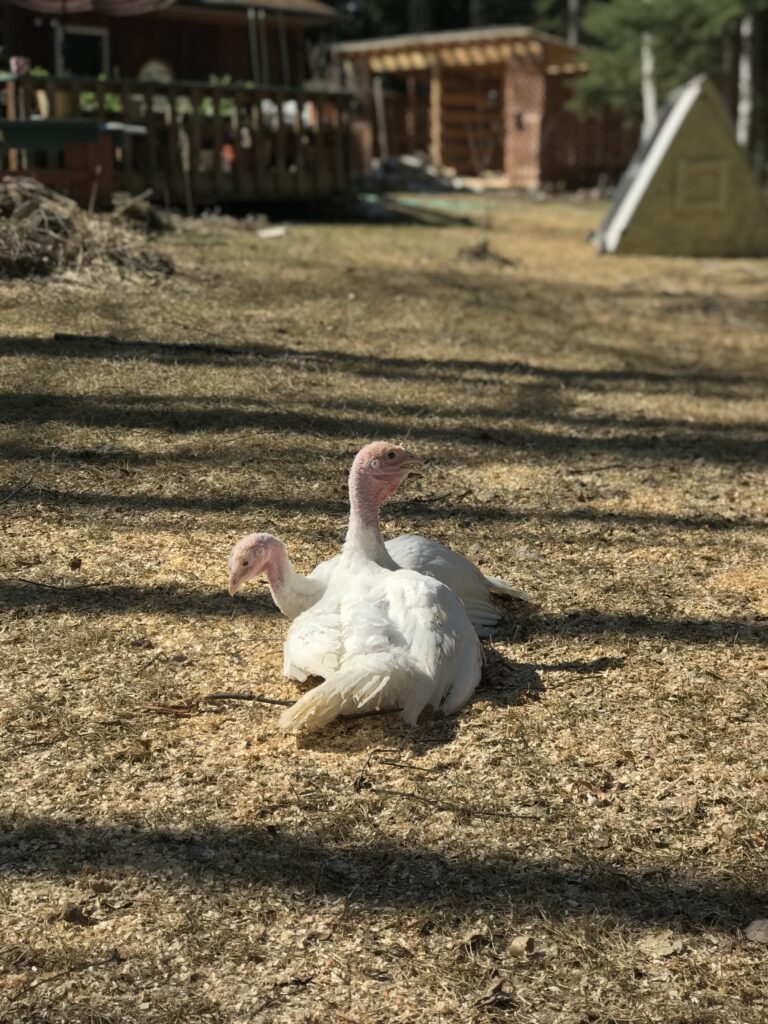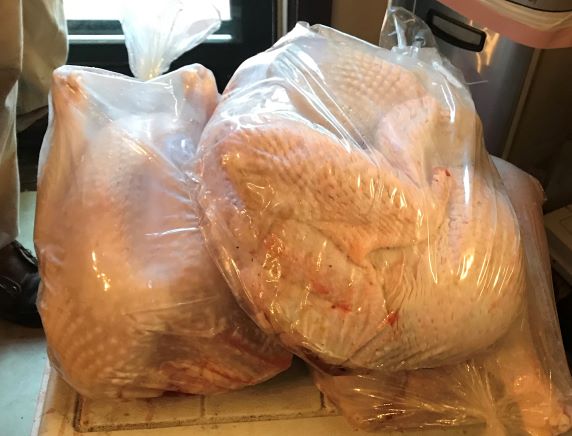Another challenge on an Alaskan Homestead; raising gorgeous turkeys
In February as Covid19 was picking up steam across the globe, my job as a Corporate Travel Agent became even more intense and the world was collectively becoming crazier and toilet paper became almost as valuable as gold we as a family began speculating.
We knew we needed to add some more laying hens to our flock since we lost a good amount during the long, cold, and hard winter of 2019-2020 but we began wondering if we had it within ourselves to raise meat birds. Turkeys to be exact. Raising poultry for meat has always seemed to me to be very difficult. I really wasn’t certain if I could do it but I guess I’ll blame the stressful situation of Covid19 that pushed me that day at Alaska Feed.
As we stood in the store assessing the small number of pullets left and picked out our four girls I quickly decided. Turkeys. Two of them. A small enough of an experiment, not too overwhelming. I was paying for the poults, the heat lamps, and the feed when the thought occurred to me that Safeway and Fred Meyers often give turkeys away when you spend over $150. I knew the feed that we were buying in late March would probably barely last till May so I would ultimately have to buy more feed so this decision was not exactly based in economics like most of my decisions.
This decision I would say was more rooted in the idea that “I wanted to be able to produce something more substantial than just a rabbit for our dining room table. I wanted to be able to produce a large meal, a holiday meal. And a turkey would do it!” It was with some trepidation and an even larger part excitement that we bounded eagerly into my husband’s truck with a box of two broad-breasted turkeys in one hand and another box of mixed pullets in the other; we were ready! We were going to do this!
Turkey poults are fragile!
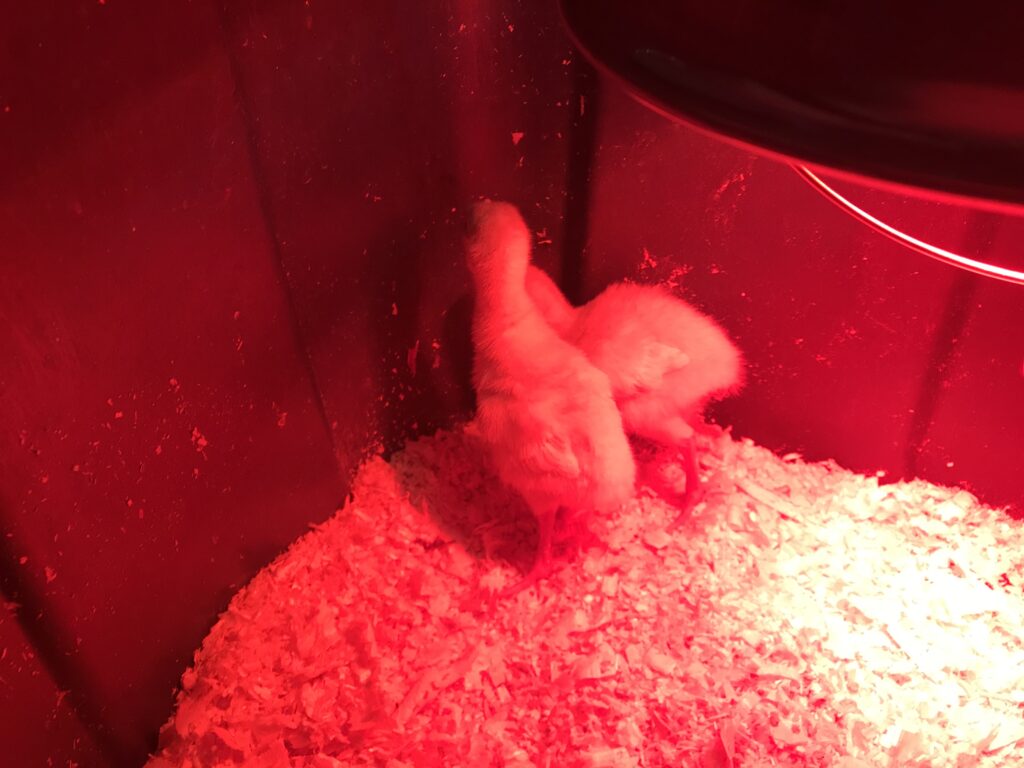
For the first couple of weeks, both our four new hens and our two new poults resided in our garage in makeshift brooder boxes that essentially were just Rubbermaid roughneck containers. We outfitted each with pine shavings on the bottom, food, and water bowls, heating lamps attached to the top that was then outfitted with thermostats that would help regulate the temperature inside their brooder boxes. I ensured the thermostat was set to 96 degrees and closely watched our new babies to ensure they were comfortable. We found if the temperature was set too cold they would huddle and shiver; too warm and they ran away from the lamp and hid in the shade.
We made sure to keep the ceramic style heating bulbs about two feet above their area as we were concerned about fire risk and we didn’t want to injure our poor little feathered friends. It was necessary to secure flexible insulation along the outsides of the containers to help keep heat in as our garage stays a chilly 45-50 degrees during the winter months. We made the mistake of not providing roosting areas for them so in the future if we decide to raise turkeys again we will be doing that. This ensures that the turkeys as they get older will stay off the ground and stay safer than they would be sitting on the ground. This summer we realized just how important this would be.
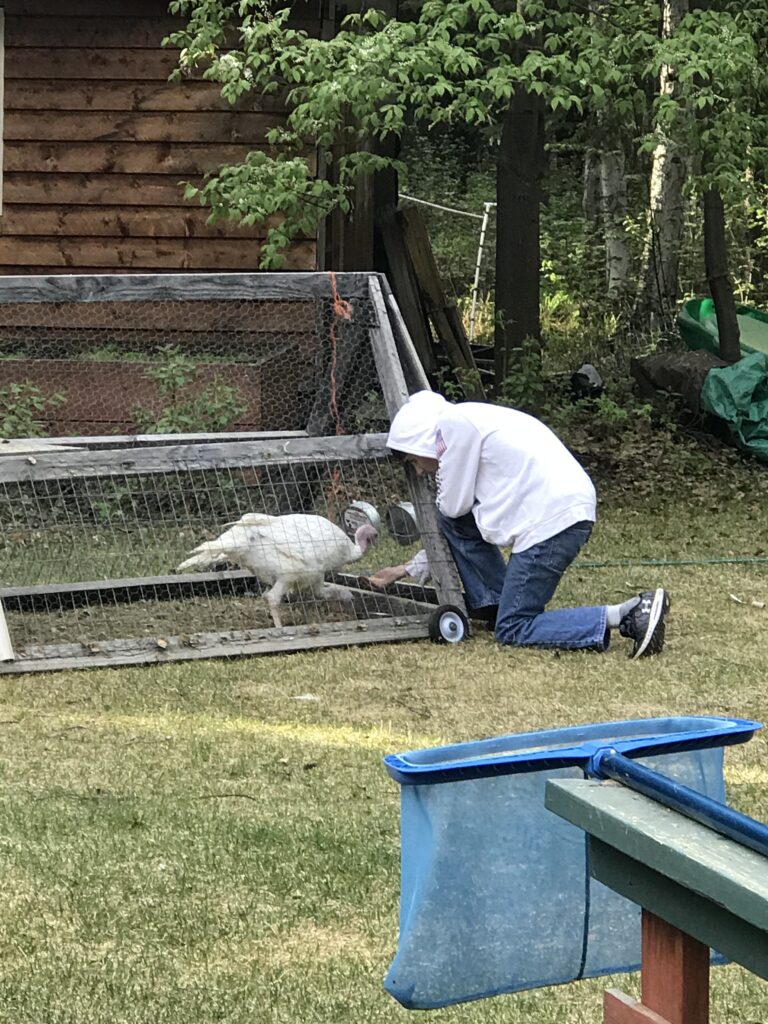
For the first couple of weeks, not much seemed to happen with the little poults. One was incredibly talkative and was equally the risk-taker while the other scurried away from us during feeding and waterings. Every couple of days we would move the turkey poults to the pullets “home” so we could empty out their bedding material and then the pullets would visit with the poults while we emptied theirs out. Typically the pullets and the poults did not really see each other more than the 5-10 minutes that the procedure took to clean out their brooder boxes. We made sure to not bring the poults together too often with the pullets as I had read that turkey poults are incredibly fragile.
They succumb to dehydration very easily, are very susceptible to Blackhead disease, Aspergillosis, Coccidiosis, and Hemorrhagic Enteritis, which meant we did our best to keep them away from the pullets. Turkey poults are also very vulnerable to Angelwing as well which is caused by protein deficiencies. This is why it is best to feed turkeys their own high protein diet rather than the feed that laying hens normally get.
Hardening off
Amusingly enough within about a month any time we were sitting in the dining room, sitting room, or talking in the kitchen, we would hear the one talkative poult non stop doing its call. Lo and behold, we came to realize this was a female however the gender of the other one did not become apparent until the middle of May. This ultimately was a blessing. We had received a male (Jake) and a female (Jenny). We had a fly fisherman friend who really wanted their feathers after we harvested them and he advised us that if we had two males they would most likely tear each other’s feathers.
This was also educational for us as none of us had ever really been around growing turkeys before. It was interesting to watch them grow up and develop their differences due to their gender. By mid-May, it became apparent it was time to start hardening them off to the temperatures outside. I had been lowering the temperature on their thermostats every week by about 5 degrees so by the time we moved them out to our movable chicken tractor the temperature in their brooder box and the temperature outside was almost similar. For several days we moved them in and out each day until we figured they had had plenty of time to acclimate to the new cooler temperatures outside.
By late May our two turkeys were no longer little babies! The male was easily 15 pounds, the female weighed slightly less at around 9 pounds. We would let them wander around the yard and most times they seemed content to either stay by our sides or eat any plant that they were not supposed to eat. (like the garlic) This led to me constantly having to chase them into other areas of the garden in hopes that they would find something else more appealing. I like to think I gave them plenty of exercise as I threw my hands up and yelled at them constantly “No, no, no it’s not time to season yourself with herbs and spices!”
It was not until July 4th when tragedy struck our homestead that we ultimately had to lock them up. We knew we did not want to lose these two to the depredations of local wildlife. From this point, they hung out in their large fenced in meat bird hutch that we built in mid-June. We would bring them huge handfuls of chickweed, plantain, and any other weed we could find that we knew they would like all the while we began contemplating what was coming up.
Butcher day would soon be upon us and the Jake who later was called “Big man” due to his wide girth appeared to be huge. We had no idea if we could do this but we had no option to not do it! Edward and I had both picked up Little Girl in mid-July and she was easily almost 20 pounds so the talk always circled around “just how heavy will Big Man be?” We would sit on our deck or on our screened in balcony quietly watching them while we speculated his weight like a carnival barker. He had to be at least 25 lbs. Maybe more? Certainly not less! My God, what would we do with a turkey that size? Did we have the room? In two weeks we found out.
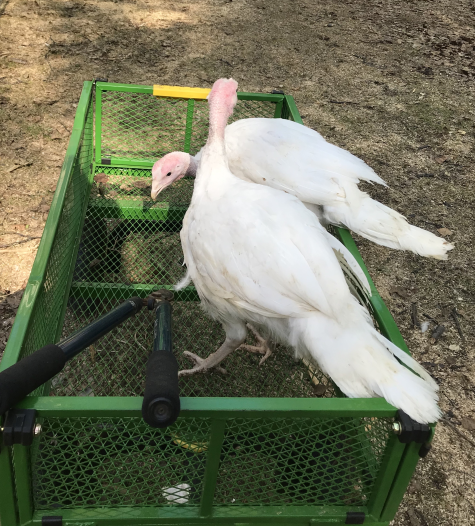
Butcher day is here
August 8th was an odd day. I started it with a cup of coffee, contemplating the tasks I had ahead of me. I had a chicken with bumble foot to treat(I wasn’t looking forward to that) and then two turkeys to dispatch, one of which I really liked.(Little Girl) The day was moving however and I know that time never really does wait for man or woman so best get to it.
After a very successful, yet nerve-wracking surgery on a poor hen with two ouchy feet, I set aside my Veterinary case for treating our animals, washed my hands, and got moving with the set up for the turkeys. Hot water bath with a dash of dish detergent; check. Sharp knives; check. Paracord has been set up for plucking feathers; check. The outdoor table has been set up for butchering afterward; check. A cooler filled with cold water brine; check. Will the cone we purchased work for the turkeys or are the turkeys too big? hmmmm. No. We grabbed a tape measure and lo and behold, Big man was simply too big. He would not fit. They say that necessity is the mother of invention and ultimately that fit here. We grabbed an extra bucket we had on hand, cut a large hole out of the bottom, hooked it to a stud in the wall in our garden shed, and voila, instant cone for hanging the turkey upside down. It was not perfect nor beautiful but it did the job.
Big Man took my husband and I both to hold and put into place. He was that heavy! When we got to the plucking stage we figured out he was about 40 lbs. By the time I had plucked, removed all internal organs, and had him cleaned up he was 33 lbs. At this size, he would not fit into our freezer shrink bags and most likely he wouldn’t fit in the oven either. We temporarily placed him into the ice-cold bath of saltwater waiting in the cooler.
Edward took pity on me when it came time to process Little Girl and after I assisted getting her into the upside-down bucket I stepped away for a moment to clean our work station and ensure the hot water bath was staying at the 140 degrees that we needed it at. Below that and the feathers come off but it is a fight to pluck them and we did not want to tear the skin of the turkey. I do not know about you, but on Thanksgiving or Christmas, that crispy skin is incredibly delicious and is quickly gobbled by the three of us.
By the time I finished my alternate duties, Little Girl had bled out and I assisted with hefting her large, heavy body over to the hot water bath. Like Big Man, we submerged her for about a minute all the while quickly turning her through the water and trying out feathers in different regions of her body. When most came out easily, with very little tugging we promptly hung her up on our paracord for the plucking process which thankfully went very quickly. The second part of removing organs and final cleaning went even better because now, after a trial and error along with watching a few video clips, we knew what we were doing.
The biggest takeaway from this process? Never, ever let turkeys get this big. When you are processing a 40-pound turkey it is hard to lift it, move it, pluck it, etc, etc. Also, the Jakes gain weight fast at the end, much faster than the Jenny’s.
When raising animals intended for meat I have found over time that it first and foremost is important to not get attached to the animal. That is sometimes easier said than done, however. I have had a couple of rabbits over time that I have become attached to, and now I can say I did enjoy having Little Girl follow me around from time to time. We are going on our 5th year of living on our property and we have been processing rabbits, and now have processed our turkeys and just as of recently processed meat chickens.
We’ve learned some amazing lessons and each time we end the day I have sighed and realized just how far we have come. We were able to give these animals good lives filled with lots of good food, sunshine, and loving care and ultimately were able to ensure that their end was as quick and as painless as we could make it. Our food did not have to travel across the globe to get to us and most of the time, even their food was locally sourced by a farm in Delta. Through all of this, I have realized, if I am going to eat meat then I would truly prefer knowing that it had a good life and not the miserable one it would typically have on a huge big-ag farm.
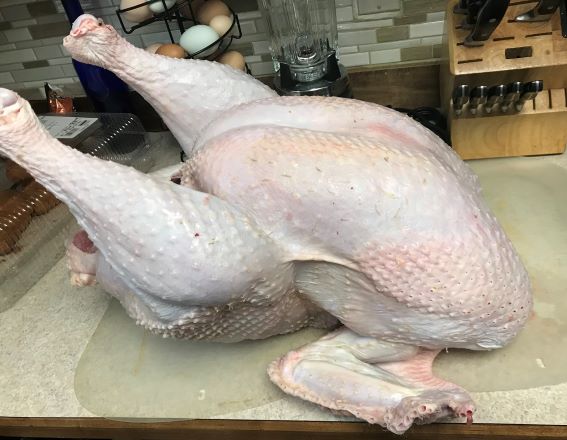
Economics of Raising Turkeys
So for the part I truly enjoy (not that I didn’t enjoy the social interactions with the turkeys), the economics of this. I wondered starting this, could I compete with grocery store prices. I know full well I can’t compete with the offer of the free turkey if you spend $150 or more at Safeway, however, could I keep up with the factory farm prices or even better yet, Organic turkey prices like you would find at a Whole Foods? CNBC reported in their November 20, 2019 article that the average price among 7 different grocers was $1.13 per pound and that was for an average Butterball turkey. Organic turkeys went for a bit more at an average of $3.11 per pound.
Technically my turkeys cannot be called “organic” because our turkeys do not have the USDA stamp nor were they fed certified organic feed. They were fed however from a mixed feed that was from S Valley Farm in Delta which is about an hour and a half drive from us. In my opinion, it was better to go with local than certified organic as I was not selling the turkeys to anyone. I used an excel form that I’ve been using for years now to track our spending for our rabbits and it served it’s purpose well. At harvest day my cost was $5.28 per pound. Had I not been setting up for the first year it would most likely have gone down a bit as you can see I had my building supplies included in this year’s turkeys as well as the heating lamp and bulbs. The price for just the turkeys versus the feed cost came out to $2.33. Not bad considering I’m a small-time grower on only 1.7 acres of land, most of which is forested at that. At the end of the day, not only can I feel good that I raised two animals with a good, peaceful life full of yummy weeds, sunlight, and exercise around our yard but I also know that the end cost wasn’t that much either. That’s a win in my book.
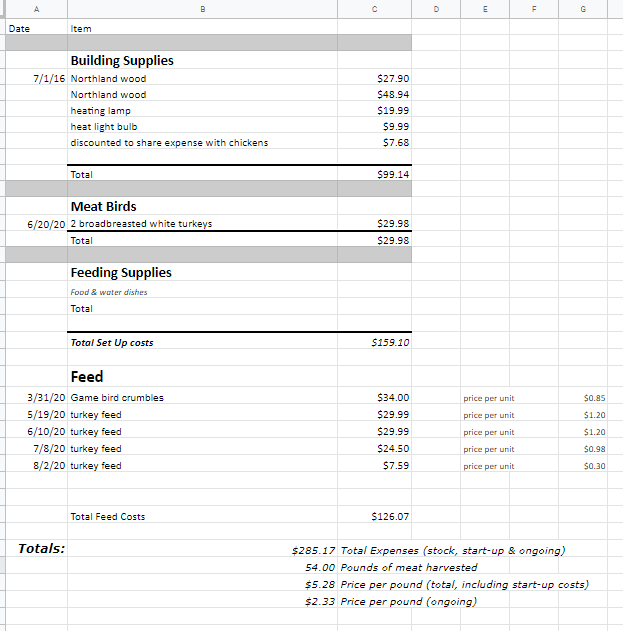
References
Arcuri, L. (2019, November 23). What Are Some Tips for Raising Turkey From Poults? Retrieved August 19, 2020, from https://www.treehugger.com/raise-turkeys-from-poults-3016806
Barnes, A. (2020, August 06). Special Care Recommendations For Turkey Chicks. Retrieved August 19, 2020, from https://opensanctuary.org/article/special-care-recommendations-for-turkey-chicks/
The Poultry Site. (2020, August 17). Parasite Management for Natural and Organic Poultry: Blackhead in Turkeys – Part 1. Retrieved August 19, 2020, from https://thepoultrysite.com/articles/parasite-management-for-natural-and-organic-poultry-blackhead-in-turkeys-part-1

